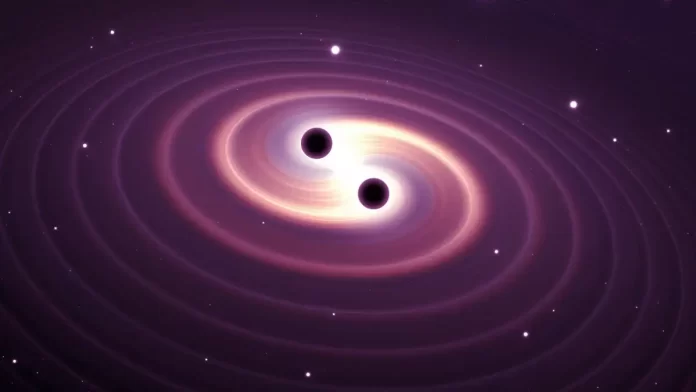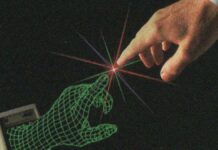
The universe is vast and mysterious, with enigmatic phenomena that continue to captivate our imaginations for research and new findings. Among these, gravitational waves are one of the great discoveries in astrophysics and cosmology. Since their first detection in 2015, gravitational waves have ushered in a new era of exploration, offering unprecedented insights into the cosmos. In this article learn what gravitational waves are, how they are detected, the origin of this theory, and the cosmic events that generate gravitational waves.
Contents
What are Gravitational Waves?
In the language of physics, gravitational waves are disturbances in the fabric of spacetime, caused by the acceleration of massive objects. The accelerated masses of binary stars and other gravitating mass motions produce gravitational waves, which have the same intensity as gravity and travel outward at the speed of light from their source.
To learn about spacetime read this article – Spacetime: The Interconnected Dimensions of Space and Time.
According to Einstein’s theory of general relativity, massive objects warp the geometry of spacetime around them. When these objects undergo acceleration or move in certain ways, they produce waves in spacetime itself. Changes in the curvature of spacetime characterize these waves and propagate at the speed of light. Gravitational wave detectors, such as interferometers, are designed to measure the tiny distortions in spacetime caused by these waves, allowing us to observe and study cosmic events and phenomena, like the mergers of black holes or neutron stars, in a new and direct way.
In simple terms, gravitational waves are ripples in the fabric of space and time. Imagine the universe as a giant rubber sheet, and when massive objects like stars or black holes move or collide, they create waves on this sheet. These waves travel through space and carry information about the objects that created them. When we detect these waves, it’s like hearing the universe’s heartbeat, and they provide us with a unique way to study and understand events in the cosmos that were previously invisible to us.
Origin of Gravitational Waves Theory
Gravitational waves theory was first proposed by Oliver Heaviside in 1893 and then in 1905 Henri Poincaré proposed it as the gravitational equivalent of electromagnetic waves. In 1916, Albert Einstein predicted gravitational waves as ripples in spacetime based on his general theory of relativity. According to this theory, massive objects like stars and black holes warp the fabric of spacetime around them, creating gravitational fields. When these objects accelerate or move through space, they send ripples, or waves, through spacetime, much like a stone creates ripples in a pond when thrown in. These waves carry information about the objects that generated them, offering a unique and direct way to study celestial events or cosmic events like supernovas that were previously hidden from our view.
The fundamental prediction by Einstein’s theory remained theoretical for a century until scientists developed the technology to detect these elusive waves. Also, there were doubts and debates about the existence of gravitational waves due to issues related to coordinate systems and mathematical approximations.
But in 1957, Richard Feynman introduced a thought experiment called the “sticky bead argument” to demonstrate that gravitational waves could transmit energy. This, followed by the work of scientists like Hermann Bondi and Felix Pirani, helped establish the existence of gravitational waves.
Despite early claims by Joseph Weber in the late 1960s, doubts arose as other experiments failed to replicate his results. In 1974, indirect evidence of gravitational waves was found when Russell Alan Hulse and Joseph Hooton Taylor, Jr. discovered a binary pulsar whose orbital period decay matched the predictions of general relativity.
The pursuit of gravitational wave detection continued, with advancements in detector technology, including laser interferometers. The breakthrough finally came in 2015 when the LIGO-Virgo collaborations announced the first direct observation of gravitational waves, resulting from the merger of two black holes.
In 2017, the Nobel Prize in Physics was awarded to Rainer Weiss, Kip Thorne, and Barry Barish for their contributions to gravitational wave detection. More recently, in 2023, evidence of a universal gravitational wave background was reported by various collaborations, providing exciting prospects for further research in this field.
How Gravitational Waves Detected?
On February 11, 2016, the teams from the Laser Interferometer Gravitational-Wave Observatory (LIGO) and the Virgo Interferometer officially told the world about the first time they directly observed gravitational waves, which happened on September 14, 2015. Before this, we only knew about gravitational waves indirectly, by how they affected the timing of pulsars in binary star systems. The observed pattern, GW150914, matched what scientists expected from general relativity, confirming that it was a gravitational wave from merging black holes. This discovery showed us, for the first time, a binary black hole merger and proved that such events happen in our universe today.
This incredible achievement received global recognition for various reasons. Attempts to directly prove the existence of gravitational waves had been ongoing for over fifty years, with even Albert Einstein questioning their detectability due to their minuscule size. The measured waves, originating from the dramatic merger, caused a small change in the length of a 4 km LIGO arm. The energy released during the event was astonishing, equivalent to the total light output from all the stars ever observed in the observable universe.
This breakthrough not only confirmed a crucial prediction in general relativity but also marked the beginning of a new era in gravitational wave astronomy. It allowed scientists to observe intense cosmic events that were previously beyond reach and potentially offered a direct glimpse into the early history of the universe. After this discovery, more gravitational wave detections were announced, such as GW170817, which was the first observed merger of binary neutron stars visible in both electromagnetic and gravitational waves.
Cosmic Events that Generate Gravitational Waves
Gravitational waves are not produced by everyday objects like planets or stars. Instead, they are generated by cataclysmic events in the cosmos.
Some of the most common sources of gravitational waves include:
- Binary Black Hole Mergers: When two black holes orbit one another and eventually merge, they release a tremendous amount of energy in the form of gravitational waves. The first direct detection of gravitational waves in 2015 by LIGO came from such an event, marking a historic moment in astrophysics.
- Binary Neutron Star Mergers: Similar to black holes, when two neutron stars spiral toward each other and merge, they also generate gravitational waves. These mergers are of great interest because they are thought to be responsible for creating heavy elements in the universe.
- Supernovae: The explosions of massive stars during supernovae events can produce gravitational waves. These waves can provide insights into the inner workings of these massive celestial bodies.
How it helped Astrophysics and Cosmology
The detection of gravitational waves has profound implications for our understanding of the universe. It allows us to explore previously hidden cosmic phenomena, answering questions and posing new ones.
Some of the key implications include:
- Testing General Relativity: Gravitational waves provide a unique way to test the predictions of Einstein’s theory of general relativity under extreme conditions. By comparing observations with theoretical models, scientists can refine our understanding of the fundamental forces that govern the universe.
- Multi-Messenger Astronomy: Gravitational wave events often coincide with electromagnetic observations, such as gamma-ray bursts and visible light emissions. This allows astronomers to study the same event using different tools, greatly expanding our knowledge of cosmic events.
- Probing the Nature of Black Holes and Neutron Stars: Gravitational waves offer insights into the properties of black holes and neutron stars, including their masses, spins, and the nature of their mergers. This information helps refine our understanding of these exotic objects.
Conclusion
Gravitational waves are a remarkable cosmic phenomenon that has revolutionized our understanding of the universe. These ripples in spacetime initially predicted and then researched by various instruments, have become a powerful tool for astrophysicists and astronomers. They enable us to explore the most violent and enigmatic events in the cosmos, offering insights into the nature of black holes, neutron stars, and the very fabric of spacetime itself.
As our detection capabilities improve, we can anticipate more groundbreaking discoveries and a deeper understanding of the universe’s most profound secrets. Gravitational waves have opened a new window into the cosmos, and the view promises to be nothing short of extraordinary. With each detection, we move one step closer to unraveling the mysteries of the universe and expanding the frontiers of human knowledge.
Sources
- Flanagan, Eanna E., and Scott A. Hughes. “The basics of gravitational wave theory.” New Journal of Physics 7.1 (2005): 204.
- Thorne, Kip S. “Gravitational waves.” arXiv preprint gr-qc/9506086 (1995).
- Cai, Rong-Gen, et al. “The gravitational-wave physics.” National Science Review 4.5 (2017): 687-706.
- Saulson, Peter R. Fundamentals of interferometric gravitational wave detectors. 1994.
- Thorne, Kip S. “Gravitational-wave research: Current status and prospects.” Reviews of Modern Physics 52.2 (1980): 285.
- Chen, Chiang-Mei, James M. Nester, and Wei-Tou Ni. “A brief history of gravitational wave research.” Chinese Journal of Physics 55.1 (2017): 142-169.
FACT CHECK: We strive for accuracy and fairness. But if you see something that doesn’t look right, please Contact us.
DISCLOSURE: This Article may contain affiliate links and Sponsored ads, to know more please read our Privacy Policy.
Stay Updated: Follow our WhatsApp Channel and Telegram Channel.











